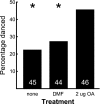Octopamine modulates honey bee dance behavior
- PMID: 17237217
- PMCID: PMC1779631
- DOI: 10.1073/pnas.0610506104
Octopamine modulates honey bee dance behavior
Abstract
Honey bees communicate the location and desirability of valuable forage sites to their nestmates through an elaborate, symbolic "dance language." The dance language is a uniquely complex communication system in invertebrates, and the neural mechanisms that generate dances are largely unknown. Here we show that treatments with controlled doses of the biogenic amine neuromodulator octopamine selectively increased the reporting of resource value in dances by forager bees. Oral and topical octopamine treatments modulated aspects of dances related to resource profitability in a dose-dependent manner. Dances for pollen and sucrose responded similarly to octopamine treatment, and these effects were eliminated by treatment with the octopamine antagonist mianserin. We propose that octopamine modulates the representation of floral rewards in dances by changing the processing of reward in the honey bee brain. Octopamine is known to modulate appetitive behavior in a range of solitary insects; the role of octopamine in dance provides an example of how neural substrates can be adapted for new behavioral innovations in the process of social evolution.
Conflict of interest statement
The authors declare no conflict of interest.
Figures



References
-
- Seeley TD. The Wisdom of the Hive. Cambridge, MA: Harvard Univ Press; 1995.
-
- Dyer FC. Annu Rev Entomol. 2002;47:917–949. - PubMed
-
- Sherman G, Visscher PK. Nature. 2002;419:920–922. - PubMed
-
- Dornhaus A, Chittka L. Behav Ecol Sociobiol. 2004;55:395–401.
-
- Frisch KV. The Dance Language and Orientation of Honeybees. Cambridge, MA: Harvard Univ Press; 1967.
Publication types
MeSH terms
Substances
Grants and funding
LinkOut - more resources
Full Text Sources
Other Literature Sources
Miscellaneous

